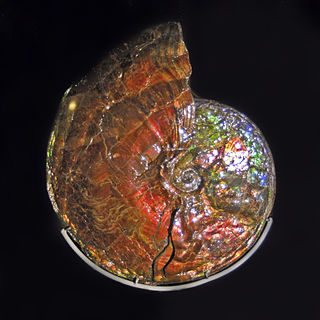
Parapuzosia is an extinct genus of desmoceratid ammonites from the Cenomanian to the Campanian of Africa, Europe, and North America. They are typically very large ammonites, reaching diameters of 60 cm (2.0 ft) or more, with the largest species measuring around 2 m (6.6 ft). It possesses a moderately involute shell with flat or slightly rounded sides. Distinct primary and secondary ribbing can be observed in the inner whorls.

Exiteloceras is an ammonite genus from the Late Cretaceous.

Mammites is a Late Cretaceous ammonite genus included in the acanthoceratoidean family, Acanthoceratidae, and the type genus for the subfamily Mammitinae. Mammites was named by Laube and Bruder in 1887.

Eubostrychoceras is a genus of helically wound, corkscrew form, heteromorph ammonite which lived during the Upper Cretaceous. The genus is included in the ancycleratid family Nostoceratidae.

Cymatoceras is a wide-ranging extinct genus from the nautilitacean cephalopod family, Cymatoceratidae. They lived from the Late Jurassic to Late Oligocene, roughly from 155 to 23 Ma.

Pachydesmoceras is a genus of ammonites belonging to the family Desmoceratidae.

Pseudoaspidoceras is an extinct genus of ammonites in the family Acanthoceratidae.

Lewesiceras is a genus of large ammonites belonging to the order Ammonitida and the family Pachydiscidae.

Neocomites is a genus of ammonite from the Lower Cretaceous, Berriasian to Hauterivian, and type genus for the Neocomitidae.
Kilianella is a genus of the ammonite family Neocomitidae. The shell of Kilianella is evolute with a slightly grooved venter and covered by strong, gently flexious, single or bifurcating ribs.

Pseudowaagenia is a genus of extinct ammonoid cephalopods in the family Aspidoceratidae.

Phyllopachyceras is an extinct genus of ammonoid cephalopods belonging to the family Phylloceratidae. These nektonic carnivores lived in the Cretaceous, from Hauterivian to Maastrichtian to age.

Pseudothurmannia is a genus of extinct cephalopods belonging to the subclass Ammonoidea and included in the family Crioceratitidae of the ammonitid superfamily Ancylocerataceae. These fast-moving nektonic carnivores lived in the Cretaceous period, from Hauterivian age to Barremian age.

Kossmaticeras is an extinct ammonoid genus belonging to the desmoceratacean family Kossmaticeratidae. Species in this genus were fast-moving nektonic carnivores. They lived during the Late Cretaceous, from upper Turonian to upper Maastrichtian age. The type species of the genus is Ammonites theobaldianus.

The Acanthoceratinae comprise a subfamily of ammonoid cephalopods that lived during the Late Cretaceous from the latter early Cenomanian to the late Turonian

Placenticeras meeki is an ammonite species from the Late Cretaceous. These cephalopods were fast-moving nektonic carnivores. They mainly lived in the American Interior Basin.

Gaudryceras is an ammonite genus belonging to the family Gaudryceratidae.

Lyelliceras is a genus of ammonites belonging to the family Lyelliceratidae. These cephalopods were fast-moving nektonic carnivores. They lived in the Cretaceous period, Albian stage.

Ostlingoceras is an extinct genus of ammonites belonging to the Turrilitidae family.

Eotetragonites is an extinct genus of ammonite.




















